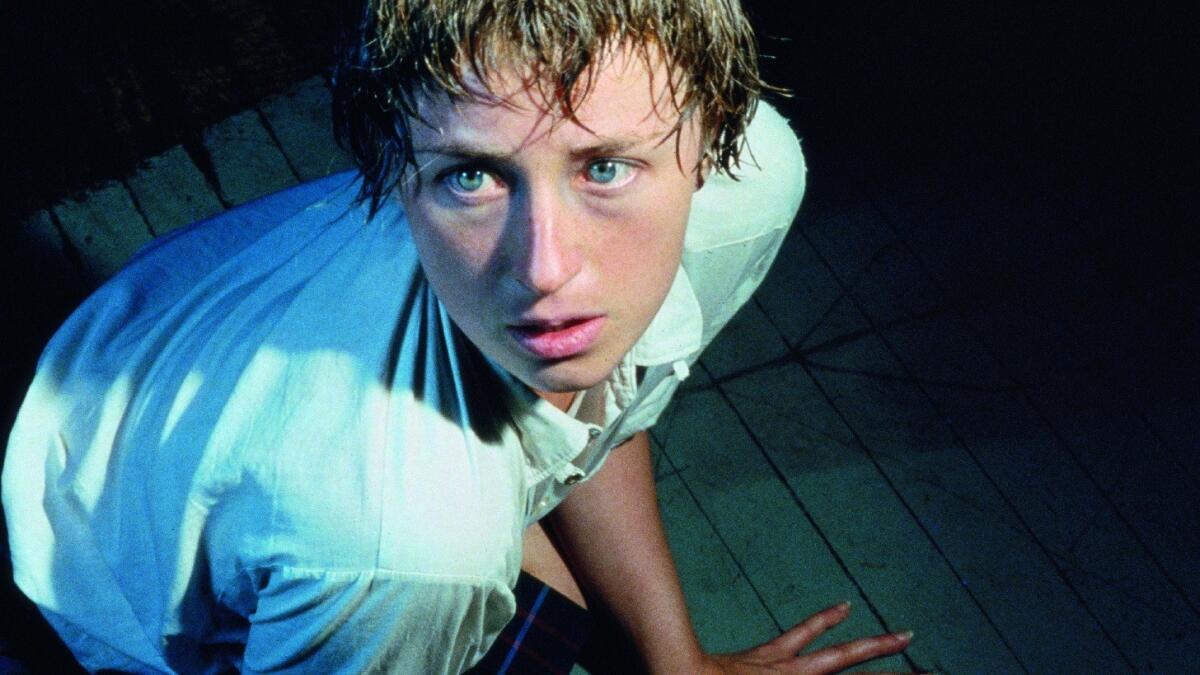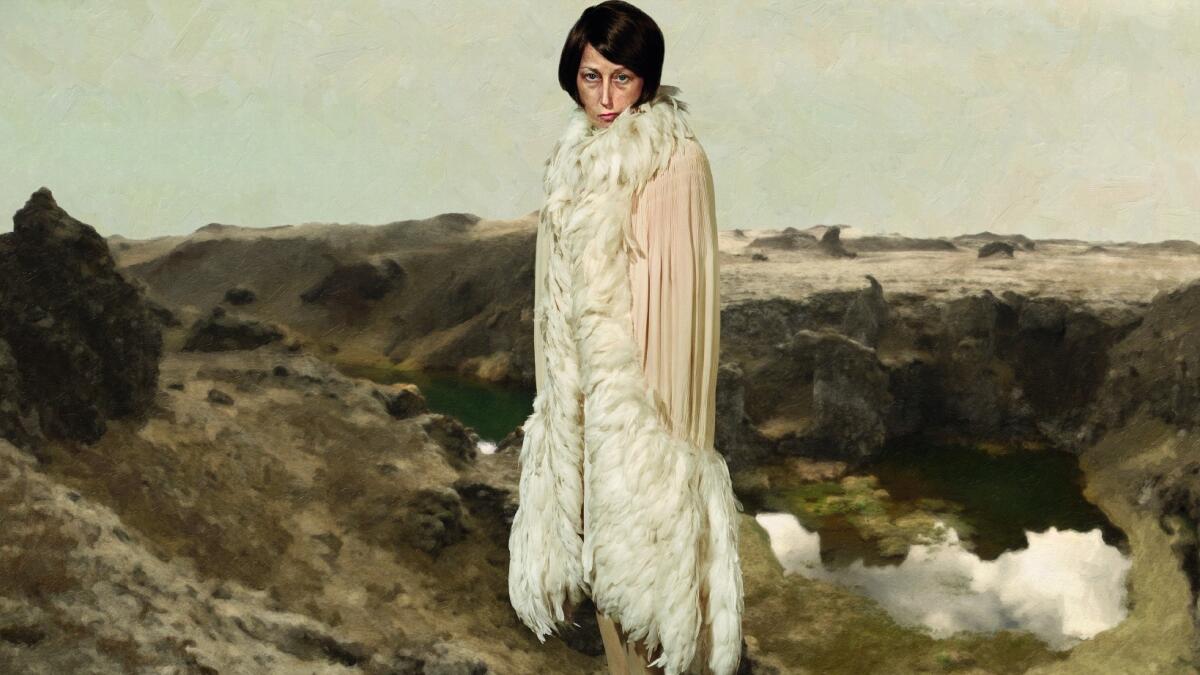Review: Art as a mirror of selfie culture? That’s ‘Cindy Sherman: Imitation of Life’
- Share via
If you have ever taken a selfie in an art museum, or if you’ve had a friend snap a cellphone picture of you there in front of your favorite painting or impressive sculpture, then Cindy Sherman has some photographs for you. They are on view at the entry to “Cindy Sherman: Imitation of Life,” the first special exhibition organized by the Broad museum since it launched last fall.
The 40-year survey of the Broad’s large Sherman collection, opening Saturday, is a mixed bag overall. (More about that in a moment.) But the two site-specific murals spanning three walls of the first room, made specifically for this exhibition, marvelously demonstrate why Sherman has ranked among the most admired American artists of the last three decades.
At first the photo murals appear fairly pedestrian, like vague billboards for some unseen product. Slowly they unfold into sly visual essays on the nature of photography, art and museums today.
Both are close-ups of a woman, one hoisting a drink in an interior with a cityscape of downtown New York buildings rising behind her, the other casting a slightly concerned look while incongruously backed by a sandy tropical beach with swaying palm trees. They’re both self-portraits, the artist costumed and coiffed as an actress would be. Her Soho and beach pictures suggest apprehensive nods to the contemporary media creation of “art and leisure.”
From Manhattan to Waikiki, tourists have always taken pictures. The ubiquity of cellphone cameras now makes it more rather than less likely that no day will go by without a user snapping a shutter at least once.
Art museums, already stuffed with pictures and relentlessly promoted as destinations for cultural tourism, have become a favorite backdrop for this new selfie culture. At the Broad, in fact, the moment that Sherman’s two murals flip from pedestrian to exciting is when a visitor inevitably positions himself in front of the big picture, pulls out the camera and shoots a selfie. As an artist whose importance derives from her brilliant insights into the intersections of photography and modern life, which distinguish our epoch from every one that has come before, surely that’s what Sherman had in mind.
Look closely at Sherman’s two murals and you’ll discover that they were made using rear-screen projections — the old Hollywood trick of photographing an actor in front of a giant photograph, in order to make it appear as if she is somewhere else. That head-spinning experience of dislocation is central to her art.
Sherman expands the dislocation to include the viewer, making her own art a kind of rear-projection for amateurs’ photographs. If the mural is a lure to attract selfies, are the photographs made in front of it unwitting collaborations with the artist?
Who is the author — the artist or the larger culture? Or is art the product of inevitable social intercourse between them? And has it always been so?
Whether you love selfie culture or hate it, the murals are the savviest take I’ve seen on a phenomenon at the core of the digital world and our burgeoning virtual reality. We shouldn’t be surprised: Sherman has been exploring the camera’s hall of mirrors for decades, dropping a trail of crumbs for us to follow as she feels her way through.
Sherman works in series, and the new murals are based on images in the first run of color photographs she made in 1980. Those were once confounding.

Street photography, mostly black and white, had been king of art’s photographic hill for decades, and claimed to represent photographic truth by casually shooting real life out in the real world. Sherman’s manipulated rear-screen projection photos put her on the streets too — but not really. She’s working alone in her studio.
By the late 1970s, some photographers were moving their cameras into their studios and embracing color. (Robert Mapplethorpe, currently the subject of a sprawling dual exhibition at the Los Angeles County Museum of Art and the Getty Museum, was another.) Constructing a studio photograph was a way to insist upon the equivalence of camera work to an established art form like painting.
Sherman, who started out as a painter, in a sense flipped the establishment terms. Rather than a photographer making art, which had been the clamor since the 19th century, she led the pack in becoming an artist whose medium is camera work — a photograph as an object, an image and a social construct.
Sherman’s 1980 color series of rear-projections built on her black-and-white self-portraits called “Untitled Film Stills,” for which she would soon become famous. Those show her in poses and wearing styles that evoke American and European movies of her childhood in the 1950s and 1960s. (Sherman is 62.)
Her most recent work picks up the theme. The show’s final gallery features seven recent photographs in which she takes on the roles of classic silent movie stars, whom Sherman portrays as being perhaps her own age or older. None is specific, but you’ll think of everyone from Lillian Gish and Gloria Swanson in the 1920s to Joan Crawford and Bette Davis performing in 1962 as fictional ‘20s silent stars Blanche and Baby Jane Hudson.
Artistically, the child is here mother of the woman. Sherman telescopes the actresses in her “Untitled Film Stills” forward and backward in time. The silent stars speak. Instead of film stills, the formal portraits are of a kind that might appear in a “whatever happened to?” magazine layout.

In one, an elegant woman sports a feather boa, old-fashioned marcel waves in her hair, one hand imperiously on her hip, the other holding a cigarette amid lacquered fingernails and a face as thickly painted as a Sargent society portrait. She stands at a window with a ship’s railing and city harbor seen outside. Sky and water are darkening, like her future. Her photographic profile is doubled as a reflection on the window glass.
Or, because this large photograph is framed behind glass for museum presentation, is her reflection on the surface of the art? She’s the ghost in the photographic machine. Sherman’s best photographs are simultaneously a window and a mirror, and the machine is far more complex than merely the mechanical camera.
New work brackets the Broad exhibition. In between are examples of her pictures of clowns, fairy tales, war, pornography, art history, fashion and more, many of them glancing off current events from the late 20th and early 21st centuries, when they were made. Many are fine.
However, virtually all of them — more than 90% of those 129 works — come from the Broad’s own collection. Many have been displayed numerous times at the former space in Santa Monica, as well as in a 2008 show at the Los Angeles County Museum of Art. A selection of “Untitled Film Stills” was in the Broad’s inaugural installation.
Billed as a comprehensive survey of Sherman’s work, “Imitation of Life” isn’t really. It’s instead a survey of the Broad’s large Sherman collection, unambitious because of the limitation.
Except for about a dozen borrowed works, guest curator Philipp Kaiser was restricted to choosing from one private collector’s purchases. The show’s catalog is a handsome souvenir picture book, but it adds little to the voluminous existing scholarship on Sherman’s essential work.
The show’s most disappointing feature is that the Broad rolled back its commitment to making the museum entrance free.
When that very welcome plan was announced in 2013, museum officials explained that some special exhibitions might carry an entrance charge to defray expenses, but a fee to visit the permanent collection, once under consideration, had been ruled out. On the evidence of its very first special exhibition, moving permanent collection from private storage on the second floor to public galleries on the first floor is apparently to be considered special.
Admission to the show is $12. The Broad has been enjoying big crowds since it opened in September. Could it be that the urge to monetize at least some of that busy foot traffic was just too much to resist?
MORE:
What's drawing millennials to downtown L.A.'s Broad museum
Cindy Sherman reveals her latest body of work — and it's personal
The biggest entertainment stories
Get our big stories about Hollywood, film, television, music, arts, culture and more right in your inbox as soon as they publish.
You may occasionally receive promotional content from the Los Angeles Times.








